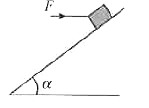A block of mass m is at rest on a rough inclined plane of angle of inclination θ. If coefficient of friction between the block and the inclined plane is μ, then the minimum value of force along the plane required to move the block on the plane is
mg[μcosθ−sinθ]
mg[sinθ+μcosθ]
mg[μcosθ+sinθ]
mg[sinθ−μcosθ]
To solve the problem of determining the minimum force required to move a block of mass m resting on a rough inclined plane with an angle of inclination θ and a coefficient of friction μ, we can follow these steps:
Step 1: Identify the forces acting on the block
1. Weight of the block: The weight W of the block acts vertically downwards and is given by W=mg.
2. Components of weight:
- The component of weight acting parallel to the incline: W∥=mgsinθ.
- The component of weight acting perpendicular to the incline: W_{\perpendicular} = mg \cos \theta .
3. Normal force: The normal force N acts perpendicular to the inclined surface and balances the perpendicular component of the weight.
Step 2: Determine the frictional force
The frictional force f that opposes the motion is given by:
f=μN
Since the normal force N is equal to the perpendicular component of the weight, we have:
N=mgcosθ
Thus, the maximum frictional force can be expressed as:
f=μmgcosθ
Step 3: Set up the equilibrium condition
To move the block, the applied force F must overcome both the component of the weight acting down the incline and the frictional force. Therefore, we can write the equilibrium condition as:
F+mgsinθ=f
Substituting the expression for frictional force, we get:
F+mgsinθ=μmgcosθ
Step 4: Solve for the applied force F
Rearranging the equation to isolate F:
F=μmgcosθ−mgsinθ
Factoring out mg:
F=mg(μcosθ−sinθ)
Final Answer
The minimum value of the force F required to move the block along the inclined plane is:
F=mg(μcosθ−sinθ)
1. Weight of the block: The weight W of the block acts vertically downwards and is given by W=mg.
2. Components of weight:
- The component of weight acting parallel to the incline: W∥=mgsinθ.
- The component of weight acting perpendicular to the incline: W_{\perpendicular} = mg \cos \theta .
3. Normal force: The normal force N acts perpendicular to the inclined surface and balances the perpendicular component of the weight.
The frictional force f that opposes the motion is given by:
f=μN
Since the normal force N is equal to the perpendicular component of the weight, we have:
N=mgcosθ
Thus, the maximum frictional force can be expressed as:
f=μmgcosθ
To move the block, the applied force F must overcome both the component of the weight acting down the incline and the frictional force. Therefore, we can write the equilibrium condition as:
F+mgsinθ=f
Substituting the expression for frictional force, we get:
F+mgsinθ=μmgcosθ
Rearranging the equation to isolate F:
F=μmgcosθ−mgsinθ
Factoring out mg:
F=mg(μcosθ−sinθ)
The minimum value of the force F required to move the block along the inclined plane is:
F=mg(μcosθ−sinθ)
Topper's Solved these Questions
- LAWS OF MOTIONBOOK - AAKASH INSTITUTECHAPTER - LAWS OF MOTIONEXERCISE - Assignment (SECTION-C)
63 Videos
- LAWS OF MOTIONBOOK - AAKASH INSTITUTECHAPTER - LAWS OF MOTIONEXERCISE - Assignment (SECTION-D) (Assertion-Reason Type Questions)
15 Videos
- LAWS OF MOTIONBOOK - AAKASH INSTITUTECHAPTER - LAWS OF MOTIONEXERCISE - Assignment (SECTION-A)
65 Videos
- KINETIC THEORYBOOK - AAKASH INSTITUTECHAPTER - KINETIC THEORYEXERCISE - EXERCISE (ASSIGNMENT) SECTION - D Assertion - Reason Type Questions
10 Videos
- MAGNETISM AND MATTER BOOK - AAKASH INSTITUTECHAPTER - MAGNETISM AND MATTER EXERCISE - ASSIGNMENT (SECTION D)
26 Videos
Similar Questions
The coefficient of friction between the block and the inclined plane is μ.
View SolutionA block of weight 1 N rests on a inclined plane of inclination θ with the horizontal. The coefficient of friction between the block and the inclined plane is μ. The minimum force that has to be applied parallel to the inclined plane to make the body just move up the plane is
View Solution
Knowledge Check
A block is stationary on an inclined plane If the coefficient of friction between the block and the plane is μ then
 .Aμ>tanθBf=mgsinθCf=μmgcosθDthe reaction of the ground on the block is mg cos θ
.Aμ>tanθBf=mgsinθCf=μmgcosθDthe reaction of the ground on the block is mg cos θA block of mass 2kg rests on a rough inclined plane making an angle of 30∘ with the horizontal. The coefficient of static friction between the block and the plane is 0.7. The frictional force on the block is
A9.8NB0.7×9.8×√3NC9.8×√3ND0.7×9.8NA block of mass m slides down an inclined plane of inclination θ with uniform speed. The coefficient of friction between the block and the plane is μ. The contact force between the block and the plane is
AmgBmgsinθ√1+μ2CmgsinθD√(mgsinθ)2+(μmgcosθ)2
A block of mass m slides down an inclined plane of inclination θ with uniform speed The coefficient of friction between the block and the plane is μ. The contact force between the block and the plane is .
View SolutionA block of mass m in the equilib rium on a rough inclined plane with inclination α and coefficient of friction as shown in the figure (μ<tanα). A force F is applied on the block which makes an angle θ with the horizontal as shown in diagram.

View SolutionA block of mass m is at rest on a rough inclined plane, whose friction coefficient is μ. Net force exerted by surface on block is :-
View SolutionA block of mass m is placed on a rough inclined plane of inclination θ kept on the floor of the lift. The coefficient of friction between the block and the inclined plane is μ. With what acceleration will the block slide down the inclined plane when the lift falls freely ?
View SolutionA block of mass m slides down with uniform speed on an inclined plane having inclination θ If the coefcient of friction between the inclined plane and the block is then the contact force between them is
View Solution
